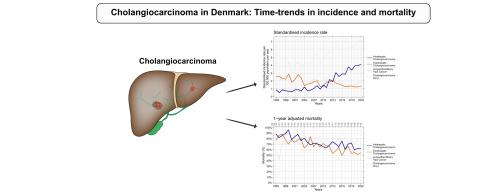丹麦胆管癌:发病率和死亡率的时间趋势
IF 7.5
1区 医学
Q1 GASTROENTEROLOGY & HEPATOLOGY
引用次数: 0
摘要
背景,血管癌预后差,在大多数国家发病率呈上升趋势。我们研究了丹麦全国队列中发病率和死亡率的时间趋势。方法:我们使用全国健康数据库对1995年至2022年诊断为胆管癌的所有丹麦公民进行识别。我们计算了年龄标准化的发病率、分期分布以及年龄和性别调整后的1年死亡率。结果5787例胆管癌患者中位年龄为72岁,女性占53%。总体而言,每10万人年的年龄标准化发病率几乎翻了一番,从1995-1998年的3.93 (95% CI 3.59-4.26)增加到2019-2022年的6.79(6.42-7.16)。肝内胆管癌的这一比率增加了5倍,从1995-1998年的0.75(0.61-0.90)增加到2019-2022年的3.85(3.57-4.13),而肝外胆管癌的这一比率从1995-1998年的2.42(2.16-2.69)下降到2019-2022年的1.30(1.14-1.47)。尽管18-59岁人群的胆管癌发病率最低(任何类型),但他们经历了最急剧的年增长(3.2% vs. 60-79岁的2.7%和≥80岁的2.1%;P为相互作用= 0.01)。在所有胆管癌患者中,局部可切除疾病的比例从2004-2006年的7%上升到2019-2022年的12%。我们发现,1995年至2022年期间,年龄和性别调整后的1年死亡率有所下降:1995-1998年为81%(77-84),2019-2022年为65%(63-68)。1年死亡率的下降是普遍的,18-59岁的患者(从1995-1998年的67%下降到2019-2022年的49%)和60-79岁的患者下降幅度最大。结论1995-2022年,由于肝内胆管癌的发病率增加,丹麦胆管癌的发病率增加。与此同时,1年死亡率下降,可能反映了早期诊断和更好的治疗。影响和启示血管癌预后不良,在大多数国家发病率呈上升趋势。在欧洲,除丹麦外,所有国家的肝内胆管癌发病率均呈上升趋势。1995年至2022年间,由于肝内胆管癌的大量增加,丹麦胆管癌的发病率增加。局部可切除疾病的比例增加,1年死亡率下降,但仍然很高(2019-2022年为65%)。了解发病率和死亡率风险对医生了解疾病、确定风险因素和设计预防保健研究很有价值;供医疗保健提供者分配资源;让病人了解他们的预后。本文章由计算机程序翻译,如有差异,请以英文原文为准。

Cholangiocarcinoma in Denmark: Time-trends in incidence and mortality
Background & Aims
Cholangiocarcinomas have a poor prognosis, and the incidence is rising in most countries. We examined time-trends in incidence and mortality in a nationwide Danish cohort.
Methods
We used nationwide health databases to identify all Danish citizens diagnosed with cholangiocarcinoma from 1995 to 2022. We computed age-standardised incidence rates, stage distribution, and age- and sex-adjusted 1-year mortality.
Results
The median age of the 5,787 patients with cholangiocarcinoma was 72 years, and 53% were female. Overall, the age-standardised incidence rate per 100,000 person-years almost doubled, from 3.93 (95% CI 3.59-4.26) in 1995-1998 to 6.79 (6.42-7.16) in 2019-2022. This rate increased five-fold for intrahepatic cholangiocarcinoma from 0.75 (0.61-0.90) in 1995-1998 to 3.85 (3.57-4.13) in 2019-2022, while for extrahepatic cholangiocarcinoma it decreased from 2.42 (2.16-2.69) in 1995-1998 to 1.30 (1.14-1.47) in 2019-2022. Although individuals aged 18–59 years had the lowest incidence rate of cholangiocarcinoma (any type), they experienced the steepest annual increase (3.2% vs. 2.7% in those aged 60–79 and 2.1% in those ≥80 years; p for interaction = 0.01). Among all patients with cholangiocarcinoma, the proportion with localised resectable disease increased from 7% in 2004-2006 to 12% in 2019-2022. We saw a decrease in age- and sex-adjusted 1-year mortality between 1995 and 2022: 81% (77-84) in 1995-1998 vs. 65% (63-68) in 2019-2022. The decrease in 1-year mortality was universal, with the largest decrease in patients aged 18–59 years (from 67% in 1995-1998 to 49% in 2019-2022) and in 60-79-year-olds.
Conclusion
The incidence of cholangiocarcinoma in Denmark increased in 1995-2022, driven by an increasing incidence of intrahepatic cholangiocarcinoma. Meanwhile, 1-year mortality decreased, likely reflecting earlier diagnosis and better treatments.
Impact and implications
Cholangiocarcinomas have a poor prognosis, and the incidence is rising in most countries. In Europe, all countries but Denmark have shown an increasing incidence of intrahepatic cholangiocarcinoma. The incidence of cholangiocarcinoma in Denmark between 1995 and 2022 increased, driven by a large increase in intrahepatic cholangiocarcinomas. The proportion with localised resectable disease increased while 1-year mortality decreased, though it remained high (65% in 2019-2022). Knowledge of incidence and mortality risk is valuable for doctors to understand the disease, identify risk factors, and design preventive care studies; for healthcare providers to allocate resources; and for patients to understand their prognosis.
求助全文
通过发布文献求助,成功后即可免费获取论文全文。
去求助
来源期刊

JHEP Reports
GASTROENTEROLOGY & HEPATOLOGY-
CiteScore
12.40
自引率
2.40%
发文量
161
审稿时长
36 days
期刊介绍:
JHEP Reports is an open access journal that is affiliated with the European Association for the Study of the Liver (EASL). It serves as a companion journal to the highly respected Journal of Hepatology.
The primary objective of JHEP Reports is to publish original papers and reviews that contribute to the advancement of knowledge in the field of liver diseases. The journal covers a wide range of topics, including basic, translational, and clinical research. It also focuses on global issues in hepatology, with particular emphasis on areas such as clinical trials, novel diagnostics, precision medicine and therapeutics, cancer research, cellular and molecular studies, artificial intelligence, microbiome research, epidemiology, and cutting-edge technologies.
In summary, JHEP Reports is dedicated to promoting scientific discoveries and innovations in liver diseases through the publication of high-quality research papers and reviews covering various aspects of hepatology.
 求助内容:
求助内容: 应助结果提醒方式:
应助结果提醒方式:


